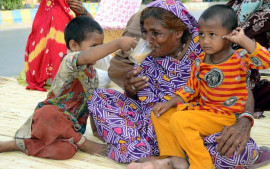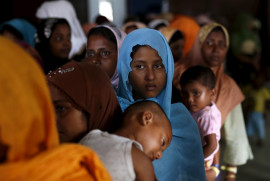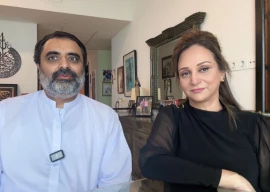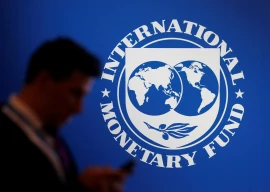PESHAWAR:
A financial crunch awaits 32-years-old Mohammad Asad once he returns to his native home in Bara tehsil. He is living at a camp in Jalozai, Nowshera district in Khyber-Pakhtunkhwa (K-P) with other internally displaced persons (IDPs) for the past four years, and has been getting free ration.
But when repatriated, the privileges he and his family enjoy in the camp will be gone and he will have to rely on his daily earning. Yet, this father of eight has no plans to practice family planning (FP) despite repeatedly being counseled at the camp. “The camp doctors provide free contraceptives but it’s a personal choice. Personally I don’t believe in contraceptives; there is enough birth spacing between my children.”
Not all IDPs at the camp agree with Asad. Mohammad Jalil, aged 30, feels a major benefit of having just three children is that the tent assigned to his family feels roomy and not congested. For Jalil, three children were enough, and he opted for contraceptives. “In fact, I only wanted two children. But we got distracted due to the displacement, and the last unwanted pregnancy happened in that confusion,” said Jalil, and commended the reproductive health facilities at the camp.
Read: Future planning: K-P conceives first population policy draft
While the FP facilities at the camp are good and the government is investing in the population and FP sector, yet the population of K-P is rapidly increasing. Finance Minister for K-P, Muzaffar Said, in his budget speech on June 15, said on the floor of assembly that “After the law and order issue, our biggest challenge is the rapidly increasing population.” He added that 30 per cent of K-P’s population comprises of children less than 15 years of age, and this population growth is eating away at all the efforts being made in the education and health sectors.
Secretary, K-P Population Welfare Department, Fazal Nabi Khan, says the province’s annual population growth rate is 2.05 per cent which is higher than the rest of the country. In Khan’s opinion, the reasons are “Low female literacy rate, the tribal culture, religious tilts and son preference are the main factors.” He cited examples of remote and relatively underdeveloped districts of the province including the Kohistan and Torghar. The contraceptive prevalence rate in these areas is very low as compared to the rest of the province.
The secretary added that the province is also affected by natural calamities and conflict. The 2010 floods and the military offensives in the tribal belts and parts of K-P caused mass migration and displacement of people in the province. “The IDPs were our guests; we provided them every FP facility at their camps,” he said. Despite the efforts, the disasters have left a mark on the FP initiatives.
The population growth rate of K-P may be high but Khan sees a positive change. “Things are improving,” he said. The contraceptive prevalence reached 28 in 2013 as compared to 25 in 2007. Similarly, the fertility rate in 2006-7 was 4.3 but in 2013 it was recorded at 3.9, while the infant mortality rate and maternal mortality rate have also decreased. Khan told The Express Tribune that among the government’s currently operative programmes, one is focused on youth. For that, they are going to setup a youth reproductive health centre in Dera Ismail Khan where psychologists and doctors will counsel youth regarding reproductive health issues. “These centers will be replicated to other districts. We are also starting a project for the counseling of new wed couples.” The already running family welfare centers, reproductive health services centers and regional training institutes are doing their bit. “The health department has a huge setup in the province. We need their help and support because people trust the doctors.”
Read: Family planning: ‘K-P to have its own population policy’
Tayyaba Khatoon has to take rude reactions and being yelled at in her stride all in a day’s work. Working as an assistant at the government-run reproductive health service centre at Peshawar’s Lady Reading Hospital, her job is to motivate females for FP. She visits female wards at the hospital and tries to persuade married women to visit their centre and talk to FP counselors. “Except for the gynecology ward where I get positive response, I face rude remarks in all other wards.” Explaining her method of talking to the women she said, “I take their family history and tell them that God has blessed you them with beautiful children, so they should adopt contraceptives and lead a joyful life with their families. Sometimes they agree; at other times they snub me or yell.”
The centre, although stationed at the biggest hospital in the area, receives just ten visitors on an average per day. The centre, with three doctors, provides vasectomy services, oral pills, injections, condoms and Implanon implants at nominal prices. Services are also provided to women from neighbouring Afghanistan. Musarrat Amir, a family planning councilor at the centre, said that women appear scared of their husbands and don’t commence any treatment without the husband’s consent. “We take consent in writing from the family before giving any treatment to any woman.”
Tayyaba expressed frustration at how the unskilled Daai or Traditional Birth Attendant (TBA) can mislead unaware women. “People usually procure contraception from the Daai; in certain cases the contraception cause adverse effect. This spreads a negative message among people about contraception, so people avoid it,” she explained.
Published in The Express Tribune, July 10th, 2015.








































COMMENTS
Comments are moderated and generally will be posted if they are on-topic and not abusive.
For more information, please see our Comments FAQ